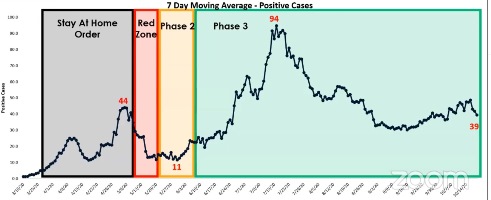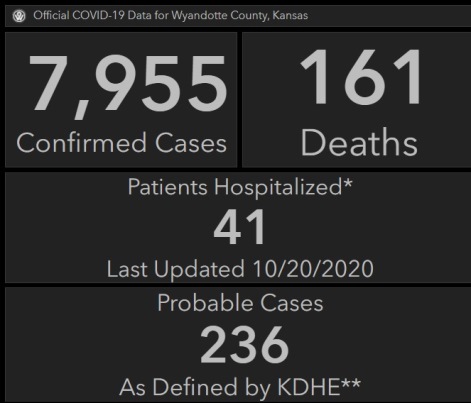


Statistics show that Wyandotte County has case rates that are twice as high as surrounding areas, according to Juliann Van Liew, director of the Unified Government Health Department.
For instance, the case rate for Wyandotte County was over 4,800 per 100,000, quite a bit higher than Johnson County’s 2,234, Kansas City, Missouri’s 2,865 and Kansas’ 2,509 per 100,000. Deaths per 100,000 in Wyandotte County also are significantly higher than surrounding areas, she said.
Wyandotte County has a much higher case rate and death rate than surrounding counties when the figures are looked at per 100,000, according to Van Liew, who spoke at Commissioner Harold Johnson’s 4th District Town Hall meeting online at 5:30 p.m. Thursday.
There are many persons here who don’t understand why Wyandotte County has different rules than some surrounding communities, she said.
“We are very invested in ensuring our community is wearing masks, sticking to those gathering limits, staying social-distanced, and we do have some health orders that are stricter than other counties,” Van Liew said. “We are starting from a different situation here in Wyandotte.”
The reason they have these health orders is because they have more of a vulnerable population and are experiencing a disproportionate amount of COVID-19 in the community, she said.
Behaviors really matter, Van Liew said. The community brought the curve down in Phase 2, but some time after moving into Phase 3, the case numbers went up again.
The community worked hard to bring that number down, she said.
“The behaviors that we implement in our daily life matter, and they show up in the numbers, and in how many folks end up in the hospital and unfortunately, pass away or survive in our community,” Van Liew said.
The UG Health Department needs to get back to its regular services at the 6th and Ann location, she said. Now testing has been moved to the former Kmart location at 78th and State, starting this past Monday. That allows regular services to resume at the Health Department at 6th and Ann.
They have tested about 150 to 200 persons a day at the new location at 78th and State, she said. They have the capacity to test 300 to 400 persons a day. It is open from 9 a.m. to 3 p.m. Monday through Friday.
The old Kmart location also will allow the Health Department to be protected from the elements and to test during the winter inside.
The tests are free for people who live or work in Wyandotte County, she said. Those with symptoms and those without symptoms can be tested.
In the next few weeks, the Health Department will add free flu shots at the Kmart site at 78th and State, she said.
For a long time, the Health Department was behind on contact tracing, but it expanded the contact tracing staff to about 20 people full-time and are on top of the contact tracing, she said.
There are health disparities with COVID-19 in Wyandotte County. The statistics showed higher rates among Asian-Americans than others. Also, Hispanic rates were three times higher that of non-Hispanic case rates. That may be due to front-line workers who cannot work from home, in part.
The Health Equity Task Force launched in April brought partners together from different race, ethnic groups and social agencies to test a large number of people, she said. It brings testing to the people, so they don’t have to go to a government building for a test, she said. They have held nearly 100 tests so far.
Van Liew urged people to wear a mask, socially distance, get tested, get a flu shot, give blood, celebrate Halloween and other holidays safely, consider restricting holiday travel and gatherings and support a proposed ban on flavor tobacco. Those who use tobacco are five to seven times more likely to contract COVID-19, experience an intense form of it and die, she said.
She thanked residents for their sacrifices in their everyday lives to help reduce COVID-19.
Wyandotte County reported a cumulative 7,955 COVID-19 cases on Thursday afternoon, an increase of 37, and there were an additional six deaths, for a cumulative total of 161.
The University of Kansas Health System reported 30 active COVID-19 patients in the hospital, nine in the intensive care unit and six on ventilators on Thursday morning, according to Dr. Dana Hawkinson, medical director of infection prevention and control. There were another 30 in the recovery period. At HaysMed in Hays, Kansas, there were 16 COVID-19 patients, with 13 active and three in recovery, he said.
Doctors were concerned that there were 20 deaths there already in October, the most deaths of any month so far in the pandemic.
At the KU Health System news conference Thursday morning, a Health Department spokesman, Janell Friesen, said that it appeared that Wyandotte County case numbers were averaging 40 or so a day, compared to about 30 a day last month. They had been at 14 to 15 percent community spread, and now are at 16.9 percent community spread, she said.
Friesen encouraged residents to celebrate Halloween in a safe way, such as holding a virtual costume contest, or going to a drive-through event. Everyone should wear a mask, not just the costume kind, but the COVID-19 kind of mask, she said, and keep 6 feet between people. She said the Health Department has more guidelines for Halloween safety.
She also urged people to vote early. If possible, people can request a mail-in ballot before Oct. 27, fill it out and then mail it or drop it off at the Election Office or at ballot drop boxes, she said.
If voting in person, residents can do advance voting early, socially distance, wear masks and use hand sanitizer. Voting early is a good idea.
“Things can come up,” she noted. People could be exposed to COVID-19 or could be sick, or they might be in quarantine on Election Day. “Vote now to make sure your vote is counted,” she said.
Mariana Ramirez-Mantilia, director of Juntos Center for Advancing Latino Health Department of Population Health, said they have been working closely on the Health Equity Task Force and with community leaders.
Several local organizations came together to bring testing availability to the community, she said.
They have tested more than 4,000 people through pop-up testing, she said, with locations including churches, community centers, libraries and schools. The positive rate has been as high as 40 percent at those events, she added.
Recently, the testing rates have been lower than previously, she said.
“We’ve seen the lack of support for those who test positive and do not have access to sick leave,” she said. The Latino community is heavily represented in the service sector, construction, food service and custodians, she added.
Some of the workers do not have access to health insurance and health care, she said.
Also, some are in multi-generational family households, and if a young child brings COVID-19 home, a grandmother or grandfather could be exposed to it.
They are working to identify more resources for the community, she said. They also have been working to provide health messages in Spanish.
At the KU Health System news conference, doctors also discussed a new report on close contact from a CDC publication. The guidance is changing from limiting exposure for 15 minutes at one time, to a cumulative time of 15 minutes in smaller segments during a day to a person who has COVID-19.
The study came from the case of a prison staff member who did not have any contact longer than 10 minutes with people who had COVID-19, but got it anyway. A lot depends on if the person with COVID-19 is in the time when he is most infectious, according to Dr. Steve Stites, chief medical officer at KU Health System.
Dr. Hawkinson said masking and physical distancing could help prevent COVID-19.
Free COVID-19 testing available
The Unified Government Health Department has moved its COVID-19 testing from the 6th and Ann location to the former Kmart at 78th and State Avenue in Kansas City, Kansas. The hours are 9 a.m. to 3 p.m. Monday through Friday.
Tests are free for those who live or work in Wyandotte County.
The tests now are open to asymptomatic people as well as those who have symptoms or have been exposed to COVID-19. Check with the UG Health Department’s Facebook page to see if there have been any changes in the schedule because of the weather or for other reasons. Bring something that shows that you live or work in Wyandotte County, such as a utility bill.
For more information about the new testing site at the former Kmart location, visit https://alpha.wycokck.org/files/assets/public/health/documents/covid/10092020_newtestingsitewyco.pdf.
Commissioner Harold Johnson’s Town Hall meeting is on Facebook at https://www.facebook.com/cityofkck/videos/649342055692564
The KU doctors’ news conference is at https://www.facebook.com/kuhospital/videos/375893720439267/.
The UG COVID-19 webpage is at https://alpha.wycokck.org/Coronavirus-COVID-19-Information.
The KDHE’s COVID-19 webpage is at https://www.coronavirus.kdheks.gov/.
The Unified Government COVID-19 hub outbreak map is at https://wyandotte-county-covid-19-hub-unifiedgov.hub.arcgis.com/.
To see an NEA list of schools that have had COVID-19 cases, visit https://app.smartsheet.com/b/publish?EQBCT=aa3f2ede7cb2415db943fdaf45866d2f.
The KC Region COVID-19 Hub dashboard is at https://marc2.org/covidhub/.
The CDC’s COVID-19 webpage is at https://www.cdc.gov/coronavirus/2019-nCoV/index.html.
